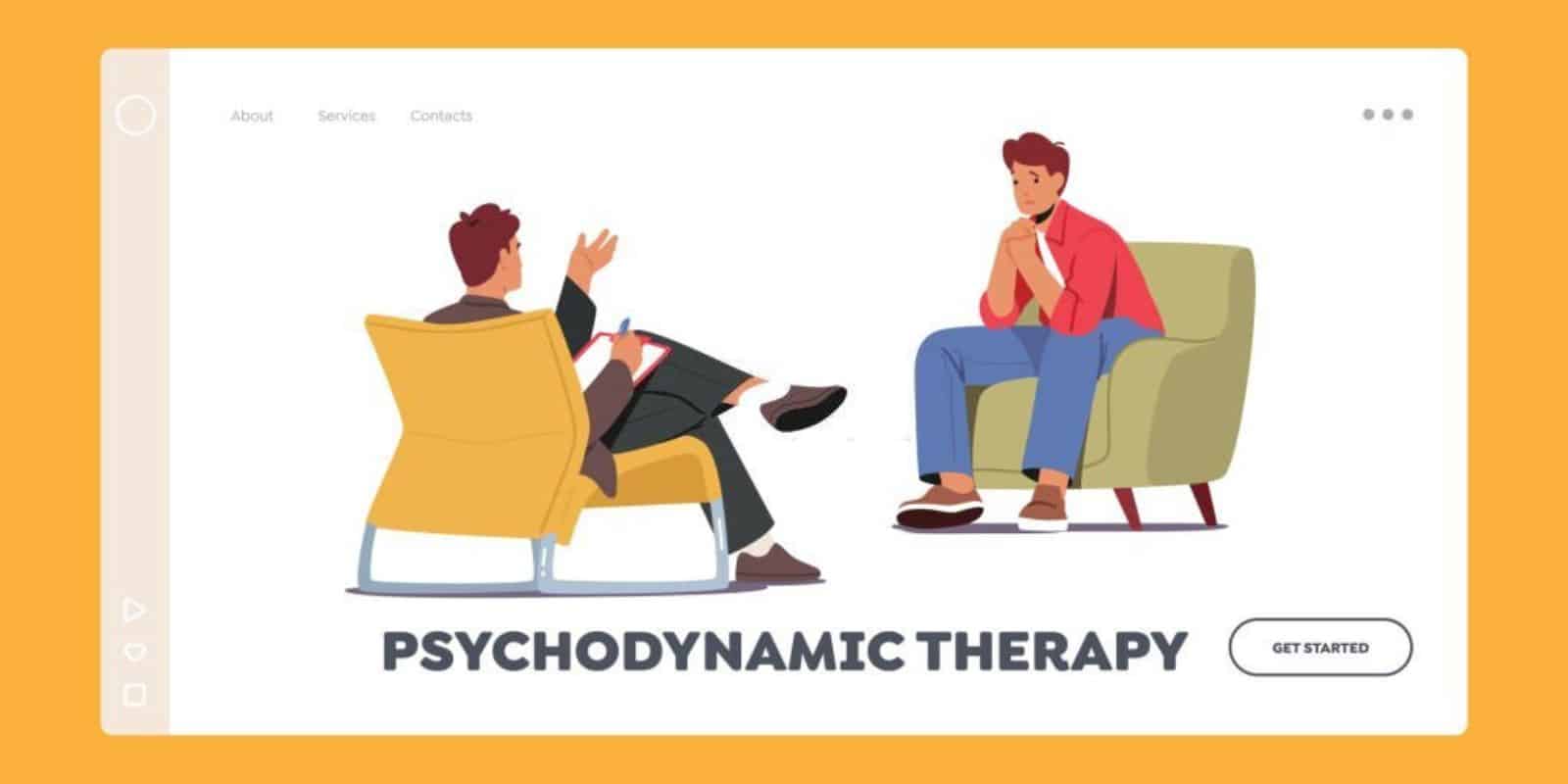Overview
Psychodynamic therapy techniques are used to peel off the layers of your thoughts and feelings and understanding yourself better can be a strong decision to empower yourself. According to Stephanie Rojas, LMHC, “Therapy is a protected space to work toward improving your mental health.”Psychodynamic Therapy, with its expertise in self-exploration, helps you do this. There are indeed many therapies present these days to do this but psychodynamic therapy holds tighter in its roots to do this for you.
While other therapies like cognitive behavioral therapy (CBT) and interpersonal therapy (IPT) have gained more popularity lately, psychodynamic therapy has proven to be the best. According to research conducted in a Medical School of UK psychodynamic therapy, response rates are approximately 70-80% by timely follow-up.
This talking therapy with many types and techniques focuses on self-reflection and aims to discover the deeper sides of your being. It focuses on the unconscious mind, exposing what hides under your emotional struggles. In front of a skilled therapist, you confront your fears, insecurities, anger, and pain directly. However, in free association, patients share their spontaneous thoughts, which helps the therapist to identify pressed materials in their unconscious mind. Finding this out helps you fix things you’re having trouble with.
Even though psychodynamic therapy may not be as widely used in recent years, it remains the most recognizable form of therapy for those new to the field. If you are someone who wants to take this therapy let’s first explore what this therapy holds, the psychodynamic Therapy Techniques, key concepts, and its different types. Because it is a worthwhile goal to understand the basics of psychodynamic therapy.
Don’t wait to take charge of your healing!
Stop letting hidden emotions control your life. CBT can help you break through emotional barriers and unlock a healthier, happier you.
What is Psychodynamic Therapy?
Psychodynamic therapy is like a kind of talking help where the counselor looks at all of you—your thoughts and feelings. Instead of just fixing specific problems, this therapy wants to understand your deep-down needs and wishes. Psychodynamic therapy is unlike other therapies that just fix surface problems. It’s not about dealing with symptoms; instead, it dives into how your mind and emotions work, not just your actions.
The therapists in this approach help you understand patterns in your feelings, thoughts, and beliefs, which gives you a better understanding of yourself. It always analyzes your childhood because those early experiences, trauma, and feelings shape who you are now.
The main aim of psychodynamic therapy is to help you find the missing pieces of your life. Sessions of psychodynamic therapy are every week and last about an hour. It is different from the old Freudian way where you’d lay on a couch. In modern psychodynamic therapy, you and the therapist sit face-to-face and talk.
In these sessions, various psychodynamic therapy techniques are practiced so you’re encouraged to talk about whatever comes to your mind, whatever you feel, and whatever crosses your mind. The therapist listens and understands how you feel and think. This therapy is often taken when you’re feeling sad or worried, and there’s some evidence that it works well.
Psychodynamic therapy wants to help you grow by making you more aware of your thoughts and feelings. It’s simply making you more aware of yourself. It values honesty and being real because that can make you happier and feel more in control of your own life. The main goal is to help you become more aware and feel more satisfied with your life.
Benefits of Psychodynamic Therapy
Psychodynamic therapy can be really helpful for people in different ways, and the good stuff might show up quickly or stick around for a long time.
- It helps you understand thoughts and behaviors you might not even realize you have.
- You start noticing more about your actions with this therapy.
- Psychodynamic therapy builds up your strength against emotional challenges.
- It supports you in dealing with issues you might not have realized were bothering you.
- This therapy works well for folks dealing with things like anxiety, depression, or eating disorders.
Goals of Psychodynamic Therapy
In psychodynamic therapy, the main goal is to make the person understand himself more, make them self-aware, and accept feelings and emotions. The therapist talks to them about looking at past experiences, especially from childhood events, upbringing, trauma feelings, and accidents, to find out how he/she is shaped now and how all these experiences affect them now.
The idea is that ongoing issues come from things deep in the mind that need to be brought out into the open for healing. So, the person needs to be aware of these hidden thoughts and understand where they come from to deal with them. Various psychodynamic therapy techniques are performed and tailored to the needs of the client.
Types of Psychodynamic Therapy
All the therapies listed below are based on the same big idea called psychodynamic theory. But, they use this theory in different ways. There are various psychodynamic therapy techniques and types mentioned below.
1. Brief Psychodynamic Therapy
Brief psychodynamic therapy differs from other types because it’s short – just like the name suggests. It only takes a few sessions, and sometimes even just one. If someone has a specific issue, sometimes they only need a few sessions to figure things out and overcome it.
Brief psychodynamic therapy can be taken to overcome things like:
- Rape
- Accidents (traffic, physical injury, etc.)
- Acts of terrorism
- Acute psychological disturbances (like anxiety or depression)
- Traumatic family events (discovery of a secret, divorce, etc.)
2. Psychodynamic Family Therapy
Family psychodynamic therapy happens within a family, to understand and resolve the dispute happening. Whether it’s parents in a relationship, parent’s relationship with their kids, siblings, grandparents, or any other family members.
This therapy lasts a longer time, it’s not like other shorter-term therapies based on CBT or IPT. It often starts if there are ongoing issues in the family rather than a specific incident or a problem.
Just like other psychodynamic therapies, this therapy looks at things happening unconsciously and unresolved conflicts, but it looks at them in the context of family relationships. The therapist guides the family through analyzing their history, especially any tough events that happened in the family.
Family therapy with a psychodynamic approach helps families find and deal with the root causes of their issues. This leads to a happier and healthier family relationship.
3. Psychodynamic Art/ Music Therapy
This type of therapy lets you express feelings through art or music. Sounds interesting isn’t it? You don’t need to be good at art or music—just use them to express yourself. You can share your art, talk about the emotions those art shows up, connect them to your childhood, or discuss what they mean to you.
Also, you can write and sing songs and therapies. This way you could light up your mood and explore your hidden patterns.
Length of Treatment
In psychodynamic therapy, how long it takes for the treatment can vary from therapy to therapy and person to person. Traditionally, psychoanalytic therapy was kind of open-ended. It used to happen weekly and continued for more than a year.
Nowadays, modern psychodynamic therapy usually has at least 24 sessions over 6 months. Short-term therapy has a limit of 20-25 sessions. People just meet with their therapist once or twice a week. In traditional psychoanalysis, it’s more common to meet three to five times a week.
Psychodynamic Therapy Techniques & Tools
In psychodynamic therapy therapies, the client performs some simple exercises and activities to learn about their unconscious mind. The five Psychodynamic Therapy Techniques and tools below are commonly used in many approaches-
1. Psychodynamic Diagnostic Manual (PDM)
The DSM, known as the clinical psychologist’s guide, helps therapists understand the behavior of clients. Psychodynamic therapists sometimes criticize the DSM for focusing only on observable symptoms. Yet there are missing personal experiences in diagnoses.
To resolve this, they came up with the Psychodynamic Diagnostic Manual (PDM) in 2006. It’s an alternative or addition to the DSM. Psychodynamic therapists find this manual more useful in diagnosing and treating clients than the standard DSM.
2. Rorschach Inkblots
The messy inkblots, linked to Freudian psychoanalysis, are still used in certain types of psychodynamic therapy today.
The Rorschach Inkblot test is often misunderstood in popular culture. Some think it’s a test that reveals everything about a person’s personality, and unique psychology and predicts mental health issues. But others see it as a pointless approach to trying to name shapeless blobs.
In this therapy, the client describes what they see. The therapist takes notes of the client’s descriptions to understand how you think and feel. It’s like a conversation about random shapes, and it helps therapists know more about the client’s thoughts and emotions. However, only trained professionals must use and interpret these results.
3. Freudian Slip
A Freudian slip is a concept in psychodynamic therapy where people unintentionally say something different from what they meant. It’s like the slip of the tongue or parapraxis, which occurs when there’s a slip in our language that underlies thoughts or feelings.
For example, someone wants to praise a friend’s idea, by saying, “I believe this plan will work!” However, they accidentally say, “Deceive this plan will work!” This slip might suggest that the speaker unconsciously shows down to the other person.
While many modern psychologists consider Freudian slips as simple linguistic errors, some argue that these slips can uncover interesting connections in the speaker’s mind. It’s like what the person thinks just speaks out.
4. Free Association
Among psychodynamic therapy techniques, there’s an approach called free association. It’s like when you’re talking to a friend about anything that’s on your mind—your week, past stuff, fears, dreams, or anything you want to share. The therapist is there to listen, paying attention to what you say, both the things you’re aware of and the things that might be hidden deep in your mind.
In this therapy, it’s like exploring different layers of what’s going on in your thoughts and feelings. It’s not just about what you know; it’s also about what might be underneath, trying to come out. So, you get to express yourself and the therapist is there to understand all the different parts of what you’re saying.
5. Dream Analysis
According to Freud, dreams show what people want, feel, and think. Sometimes, these desires are not okay with society, so people hide them deep inside. Later, these hidden thoughts come out in their dreams. And these dreams secretly affect how we act.
When a therapist uses dream analysis in psychodynamic therapy, they listen to what the client dreams about and help them figure out what those dreams mean. The therapist thinks that dreams can show things in our minds that we might not know about.
In therapy sessions, the therapist asks the client to talk about their dreams, like who was in them, where they happened, and how they felt. By doing this, the therapist tries to find special things and hidden problems in the dream. Then, the therapist and the client work together to understand what these special things might say about the client’s life and the things they go through every day. It’s like solving a mystery to learn more about the client’s feelings and thoughts.
Psychoanalysis: The Freudian Approach
There is a similar approach that was used earlier known as psychoanalysis, given by Freudians. Although it shares roots with modern psychodynamic therapy, there are key differences.
Firstly, psychoanalysis requires more time and commitment compared to new psychodynamic therapy. Instead of weekly sessions, psychoanalysis happens two to five times per week. The process somewhere lasts more than a year.
Another difference is how the therapy room is set up. In psychoanalysis, the person getting help lies on a couch, and the therapist sits behind them. In new psychodynamic therapy, the therapist and client both face each other in a talking session.
The relationship between the therapist and the client in psychoanalysis is so formal. The therapist makes a distance, The Therapist was seen as an expert not so friendly with the client. On the other hand, the therapist is very friendly and makes the client feel more comfortable around them.
However, in many places, psychoanalysis is performed. However Psychodynamic is more effective because therapists now play a more equal role. Making sure to balance the hierarchy better for treatment.
In simpler terms, psychoanalysis is like an older version of psychodynamic therapy with more intense sessions, a specific room setup, and a less equal relationship between therapist and client. Today, things have changed to make therapy more balanced and accessible for everyone.
Role of the Psychodynamic Therapist
In psychodynamic therapy, the therapist plays the role of a guide and listener. Their job is to help you talk about your thoughts and feelings, believing that a lot of what you feel is hidden inside. They carefully listen to you and encourage you to share whatever is on your mind. They are like your mirror to see and know about you.
The therapist asks questions to understand your experiences and helps you see patterns in your thoughts and emotions. It’s like exploring a map of your feelings together. Psychodynamic therapy techniques, aim to create a safe space where you can open up about things that might be bothering you. They don’t judge you, they just focus on the surface problems and try to understand what’s going on beneath, helping you discover more about yourself.
To pick the right psychodynamic therapist:
- Look for local experts.
- Read reviews and check credentials.
- Have an initial chat to see if you connect.
- Trust your feelings.
- Consider logistics and costs.
- Choose someone who makes you feel comfortable and supported.
How Does Psychodynamic Therapy Techniques Help Depression?
According to the American Psychological Association (APA), depression is the most common mental disorder worldwide.
There are three main types of therapy for treating depression: psychodynamic therapy, cognitive behavioral therapy (CBT), and interpersonal therapy (IPT). They differ in what they focus on.
Psychodynamic therapy helps with depression by digging into deeper emotions and thoughts. Instead of just changing behaviors, it explores hidden issues and childhood experiences. This self-discovery brings better understanding, leading to improved mental well-being.
Psychodynamic Therapy Techniques in Relationships
Psychodynamic therapy helps couples face unspoken conflicts by delving into their emotions and past experiences. It’s like relationship counseling, using free association and catharsis to understand each person’s mindset.
During the therapy, the counselor analyzes the conflicts, evaluates emotional needs, and clarifies past issues. Fears and insecurities are discussed openly. The therapist also examines relationships with family and friends to understand social behaviors.
The goal is to build trust and understanding between partners, helping them become more tolerant and adaptable. The focus is on resolving past issues for a healthier relationship.
Your Journey to a Brighter Tomorrow
FAQs- Psychodynamic Therapy Techniques
1. What methods are used in psychodynamic therapy?
Psychodynamic therapy uses conversation, free association, and exploring unconscious thoughts to enhance self-awareness and improve relationships
2. Is CBT a psychodynamic therapy?
No, CBT (Cognitive Behavioral Therapy) is not psychodynamic therapy; it focuses on changing thought patterns and behaviors, while psychodynamic therapy explores unconscious thoughts and past experiences.
3. How many sessions do I need for psychodynamic therapy?
The number of sessions can vary, but brief psychodynamic therapy usually involves no more than 25 sessions.
Conclusion
In conclusion, Psychodynamic therapy is about making hidden thoughts known to improve how we relate to ourselves and others. The therapist helps by revealing the unconscious thoughts in conversations and connecting past experiences to current personalities. This increases self-awareness and brings positive changes and potential recovery from past traumas. Hence, choosing the right therapist is important for this therapy to work well.
Calusa Recovery offers an intensive outpatient program designed to facilitate the journey to long-term mental wellness. The program addresses underlying causes of distress, imparts coping skills, and promotes balance and healing of the mind, body, and spirit. The goal is to empower individuals with passion and purpose. The dedicated team caters to diverse needs, ensuring clients leave motivated, healthy, and prepared for a new life within a supportive community. Calusa’s comprehensive services enable clients to apply what they’ve learned in the program to their lives alongside others who have achieved long-term health and happiness.










